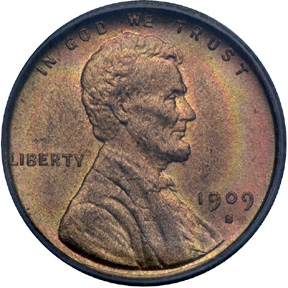 These days Americans accept and expect famous faces on our coins: Washington quarters (first minted in 1932), Jefferson nickels (1938), Roosevelt dimes (1946), Franklin (1948) and Kennedy (1964) half-dollars, Eisenhower (1971), Susan B. Anthony (1979), and Sacagawea (2000) dollars. But from first United States coinage in 1793 until 1909, no coin had the image of a real person on it. In 1909, however, Pres. Theodore Roosevelt wished to commemorate the 100th anniversary of Abraham Lincoln’s birth by putting Honest Abe’s face on a coin.
These days Americans accept and expect famous faces on our coins: Washington quarters (first minted in 1932), Jefferson nickels (1938), Roosevelt dimes (1946), Franklin (1948) and Kennedy (1964) half-dollars, Eisenhower (1971), Susan B. Anthony (1979), and Sacagawea (2000) dollars. But from first United States coinage in 1793 until 1909, no coin had the image of a real person on it. In 1909, however, Pres. Theodore Roosevelt wished to commemorate the 100th anniversary of Abraham Lincoln’s birth by putting Honest Abe’s face on a coin.
In spite of Lincoln’s popularity, however, not all were in favor of his image on a coin. In addition to setting a “monarchical” precedent (originally kiboshed by George Washington), some were opposed for less worthy reasons:
–Since 1861, one-cent coins had the head of an Indian on them, perceived by many as an unique symbol of America. Ironically, it is rumored that the model for the Indian Head cent was the daughter of the coin’s designer, James Barton Longacre, engraver at the Philadelphia Mint…not a Native American.
–With memories of the Civil War still fresh, many Southerners opposed honoring Lincoln this way.
–The image of Abraham Lincoln that Pres. Roosevelt wanted to use was sculpted by Victor D. Brenner, a Jewish immigrant from Lithuania. U.S. Mint artists were envious and some say, prejudiced. (New York Times archives include this empassioned 1909 letter to the editor championing Brenner.)
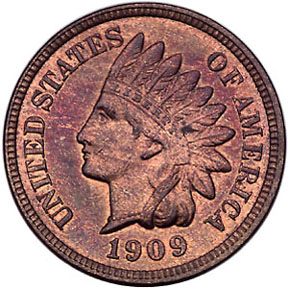 The U.S. Mint began 1909 by coining Indian Head cents, but Pres. Roosevelt prevailed, and the Mint began stamping Lincoln cents in May. When the Lincoln Head cents were released to the public on August 2, 1909, long lines formed outside Treasury Department offices. Each person in line was limited to one dollar’s worth of coins. Some small-time entrepreneurs, many of them kids, resold the new coins, three for a nickel,
The U.S. Mint began 1909 by coining Indian Head cents, but Pres. Roosevelt prevailed, and the Mint began stamping Lincoln cents in May. When the Lincoln Head cents were released to the public on August 2, 1909, long lines formed outside Treasury Department offices. Each person in line was limited to one dollar’s worth of coins. Some small-time entrepreneurs, many of them kids, resold the new coins, three for a nickel,
The new coins were especially popular among Black Americans; some called the coins “emancipation money.” A short article published by the New York Times on August 6, 1909, reads:
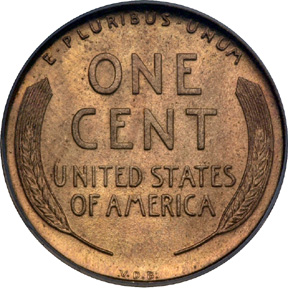 But on August 4, only two days after the coins were released to the public, the head of U.S. Treasury, citing upset at the size of Brenner’s initials on the back of the coin, stopped production and had the VDB removed from the dies.
But on August 4, only two days after the coins were released to the public, the head of U.S. Treasury, citing upset at the size of Brenner’s initials on the back of the coin, stopped production and had the VDB removed from the dies.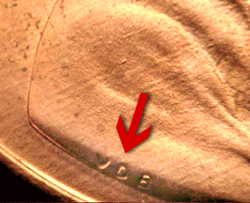 These initials ultimately returned to the Lincoln cents in 1918, so small one needs a magnifying glass to see them, on the front of the coin etched into the bevel just below Lincoln’s shoulder.
These initials ultimately returned to the Lincoln cents in 1918, so small one needs a magnifying glass to see them, on the front of the coin etched into the bevel just below Lincoln’s shoulder.
Since both the Philadelphia and San Francisco Mints produced one-cent coins, there were six different cents minted in 1909, in hugely varying quantities:
The Indian Heads are valuable. The Lincoln cents with no VDB are not so valuable, but the VDBs are extremely rare. And the 1909-S VDB, because there were many fewer coins made in San Francisco than in Philadelphia, are the most valuable of all…by far.
Beginning on Lincoln’s birthday in a few days, four new designs will appear on the reverse of the coin, one every three months, with a fifth design appearing in 2010.
“Find a penny, pick it up. All day long, you’ll have good luck.” Now most of us won’t bother.
According to the New York Times, “probably no art object in human history has been reproduced more often: by the end of [2006], 444,039,035,418 times.” That’s well over half a trillion by now. But how long Lincoln’s likeness will stay on the one-cent coin is uncertain because the future of the penny is in doubt. It now costs the government more than a cent to make a one-cent coin, and there are many who question the penny’s usefulness and want to be rid of the one-cent coin altogether.


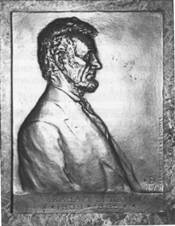
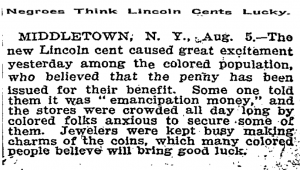

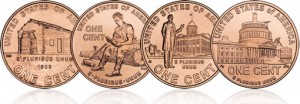




8 Comments on “Lincoln Head Cents: 1909-2009 and Beyond…”
I’ve often wondered what brick & mortar stores would do if the penny was no longer available. Most US business takes place without cash these days, but if I go order a sandwich at the local deli and it costs $4.50, there’s going to be tax on that and here come the 1 cent coins. Will they just round up?
Will cashiers have to learn rounding? Will I have to learn rounding? Ugh. And how will that impact non-cash sales and debts?
Also, my grandfather’s parents came to the US from Lithuania and his name was Victor. Guess it’s a popular one over there.
On the 200th anniversary of Lincoln’s birth, February 12, 2009, a number of merchants in Concord, MA, will begin refusing to accept pennies. They will round down to the nearest nickel and toss all pennies offered into a charity jar.
http://www.wickedlocal.com/concord/news/business/x565954293/Planned-penny-protest-gains-momentum-among-businesses
Brenner was born Viktoras Barnauskas.
got to get that 2010 cent it could be the last.
i am a coin collecter, and i specialize in pennies. i learned something new here.
i have a 2002 penny with the small outline of alabama on it. with al spelled in the middle of it. whats with this?
State cents are, to my knowledge, privately reminted coins…pennies that have been restamped with a state design.
I don’t know where to begin, this is my first time searching for the 20.09 Lincoln penny but cannot find an image of the penny I have on the web.
The penny I have shows Lincoln with the embedded image of an Indians head piece of what seems like the raccoon head then the main of feathers, not sure what it’s called but it’s embedded on Lincoln’s shoulder/arm above/beside the noticeable VDB and the date showed as 20.09 with no letter below or above. Clearly it is something not meant to be released/ circulated since I cannot find anything similar on the web.
Anyone who is into coins, I’d like to know if im holding something valuable.
From your description I’m guessing that someone took a Lincoln cent and overstamped it with another image. For example, no date should have a dot in it (20.09).
It probably has little if any value, but any reputable coin dealer could tell you with one quick look.
Comments are closed.